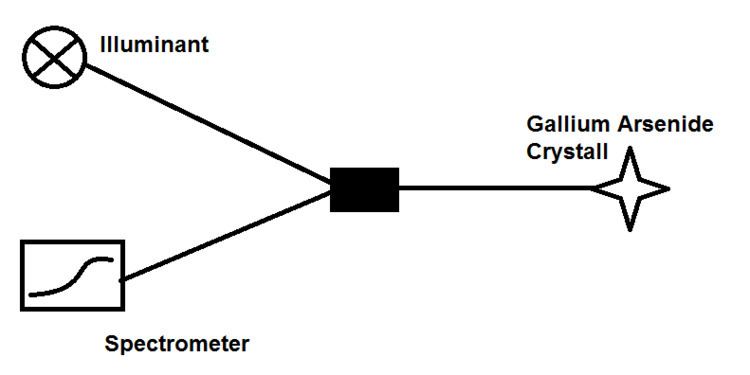 | ||
Fiber optical thermometers can be used in electromagnetically strongly influenced environment, in microwave fields, power plants or explosion- proof areas and wherever measurement with electrical temperature sensors is not possible.
Contents
Structure
One type of fiber optic temperature probe consists of a gallium arsenide (GaAs) semiconductor crystal that is mounted on the end of an optical fiber. The probe is completely non-metallic. The fiber optical sensor is completely non-conductive and offers complete immunity to RFI, EMI, NMR and microwave radiation with high temperature operating capability, intrinsic safety, and non-invasive use.
Measurement principle
The principle of operation is based on the temperature dependence of the band gap of GaAs. The GaAs crystal fixed on the tip of the fiber will be transparent at a wavelength above 850nm. The position of the band edge is temperature dependent and is shifted about 0.4nm/Kelvin. The light is directed via the optical fiber to the crystal, where it is absorbed and partially reflected back into the fiber. A miniature spectrometer provides a spectrum with the position of the band edge, from which the temperature is calculated.
Medical
Fiber optic sensors offer complete immunity to RF and microwave radiation with high temperature operating capability, so they can be used for measurement on patients and materials in magnetic resonance scanner (MRI). Metallic sensors can breed errors at the image acquisition. For special cancer treatment sensors with a diameter of 0,5 mm are available. These can be used minimal invasive for monitoring of tissue temperature. Another application of fiber optical measurement technique is laser therapy. Through an endoscope laser energy is coupled and the temperature will be measured via a fiber optic probe at the location of therapy.
Environmental
Industrial areas are often contaminated of the soil by oil, toxic and persistent organic compounds. To clear this fields a soil heating by radio waves is frequently used. Fiber optical sensors are deployed to monitoring and controlling this process. A high- power generator will deliver energy in radio frequency range. The polluted soil is covered with electrodes, which will heat the surface dielectric. Besides, several fiber optical probes are put in the soil. Depending on the measured value different values of temperature and temperature distribution can be realized in the soil. Depending on the level of contamination the temperature will be increased slightly to activate a higher decomposition of soil organisms, alternatively the soil water will condensate in a temperature range up to 150° Celsius together with non-steam resistant organic contaminations. A perforated soil air extraction system takes the steams away and recirculates them into a filter system.
Chemical and petrochemical
Fiber optic temperature probes are designed to withstand harsh and corrosive environments. The sensors are intrinsically safe. There are no components which create sparks, leading to explosions. They consist of completely non-conductive components and can therefore be used in hazardous areas. They can have a length up to 2,5 miles, so that the analysis can be placed outside the hazardous area.
Microwave and radiofrequency environments
In microwave heated installations chemical digestion under pressure and temperature for the determination of trace and ultra-trace analysis in downstream processes will be executed, for that reason it was found that under certain pressure and temperature conditions, the yield or efficiency of extraction or digestion processes could be significantly improved. So fiber optical temperature sensors are the only way to control temperatures in microwave chemistry.
Generator and transformer
The claims of a modern society relating to electricity requirement approach the full capacity of the generating stations. To ensure industrial safety the temperature must be tightly controlled. High power generators are often filled with hydrogen in order to cool effectively. Besides the heavily contaminated electromagnetic environment the risk for explosions is high. Only fiber optical thermometer can be used for measurement in this areas.
Wood drying
In the renovation of wooden structures can control the core temperature of the wood on a fiber-optic temperature probe beams in place. The thermal drying of wood components in the installed state between 80 and 95 ° C is sufficient to effect the dry rot infestation to combat and prevent damage. The probes used for temperature measurement consist of a jacketed PTFE glass fibers with a GaAs crystals (Gallium arsenide) tip and are completely non-metallic.
Electric motors
In the industry, the machinery and equipment is increasing to the limits of their strength exhausted. An engine with a larger or smaller size can be used to gain or loss of a job lead. On the consumer side as well on a high mileage engine value set. Fiber optic temperature measurements without external effects (magnetic fields, radio frequencies, microwaves) can work quickly and easily even in hazardous areas. They can used easily to measure the stator winding temperature of an engine or the bearing temperature. The sensors help to detect temperature changes quickly to report the fact to initiate preventive measures.
Fiber optic vendors
There is a large number of vendors and distributors all over the world. The measurement principle of the thermometers vary in style, most are actually slight variation of radiation thermometers, other depend upon contact with the object of measurement.
